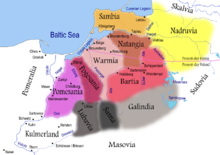Chełmno Land
This article needs additional citations for verification. (November 2006) |
| Province of Culm Kulmerland | |||||||
|---|---|---|---|---|---|---|---|
| of Monastic State of the Teutonic Knights | |||||||
| 1226–1466 | |||||||
 Map of Prussian tribes (coloured areas) in the 13th century. Kulmerland (Chełmno Land) in the south west already under control of the Teutonic Order | |||||||
| Capital | Culm | ||||||
| History | |||||||
• Established | 1226 | ||||||
• Second Peace of Thorn (1466) | 1466 | ||||||
| |||||||
Kulmerland (Culmerland, Culm land, Polish: ziemia chełmińska, German: ⓘ) is a German name of a historical region in central Poland bounded by the Vistula and Drwęca rivers.
Kulmerland is named after the city of Chełmno (also known as Culm). The largest cities in the region are Toruń, Grudziądz, Chełmno, and Chełmża. Sometimes it was considered to be part of the neighbouring provinces of Masovia, Kuyavia, Greater Poland, Prussia, and Pomerania; it is currently part of the Kuyavian-Pomeranian Voivodship. Culmigerier was one of the names of the Prussians in general.
It is located on the right bank of the Vistula river, from the mouth of the Drwęca river to Chełmno. Where the Vistula river takes a sharp turn northward, the Drwęca forms the eastern border of the region, while its southern and western border is the Vistula river.
History
The first historical account of Kulm and Kulmerland dates back to 1065 when Boleslaw II of Poland granted a tax privilege to an abbey in a nearby Mogilno. The document lists Kulm ("Culmine") along with other towns which then belonged to the province of Masovia. Culmigeria, being closest to the Polans, came to be populated by the Lechitic Kuyavians and tribes from Greater Poland. The Masovians were led by Masos, who left the Polish duke Boleslaw I and sought refuge with the Prussians. When this area was subdued by the rulers of the Polans Chełmno became a local centre of administration (kasztelania). Chełmno Land was Christianised in the 11th century.
According to the will of Duke Boleslaus III of Poland, Culmigeria after his death in 1137 became a part of the Duchy of Masovia governed by his son Boleslaus IV the Curly and his descendants during the feudal fragmentation of Poland. However the Prussians as well as the Pomeranians many times managed to regain their freedom from subjugation by the expanding Polish dukes.
By the 13th century the territory was subject to raids by Prussians, who sacked Chełmno, the province's main town, in 1216. In 1220 Conrad I of Masovia, with the participation of the other princes of Poland, led a partial reconquest of the province, but the project of establishing a Polish defense of the province failed due to conflicts between the princes. He brought the crusading Knights of Dobrin to Masovia, where they built a castle at Dobrzyń in 1224 as a base for attacks against the Prussians. As a result the territory was again sacked and devastated by Prussian raids, which led to depopulation of the province.
Being involved in dynastic struggles elsewhere and too weak to deal with the Prussians alone, Conrad needed to safeguard and establish borders against the heathen Old Prussians, because his territory of Masovia was also in danger after the Prussians besieged Płock. Conrad awarded the already devastated Chełmno Land to the Teutonic Knights, giving them Nieszawa at first. He also brought in German settlers to Płock.
In 1226 Duke Conrad I of Masovia enlisted the aid of the Teutonic Order to protect Masovia and help convert the Prussians to Christianity. In return, the knights were to keep Chełmno Land as a fief. The land constituted the base of the Monastic State of the Teutonic Knights, and its later conquest of East Prussia, marking the German Ostsiedlung.
The Teutonic Order obtained an Imperial bull from Emperor Frederick II before entering Prussia. In 1243 the papal legate William of Modena divided Prussia into four dioceses under the archbishop of Riga, one of which was Chełmno Land.
After the Thirteen Years War between the Prussian cities and the Teutonic Knights ended with the Second Peace of Thorn (1466), Chełmno Land returned to the Polish crown as a part of autonomous Royal Prussia (see Chełmno Voivodship).
In 1772 as a result of the First Partition of Poland, Chełmno Land (with the exception of Toruń) was seized by the Kingdom of Prussia. Between 1807 and 1815 Chełmno Land was a part of the Duchy of Warsaw. In 1815 it become part of the Grand Duchy of Poznań, but in 1817 was incorporated into West Prussia.
Following the Treaty of Versailles, Chełmno Land was returned to Poland in January 1920. It was occupied in the Invasion of Poland in September 1939 by Nazi Germany and annexed in October. In January 1945 it was captured by Red Army and returned to Poland.
References
- Ziemia Chełmińska w przeszłości: wybór tekstów źródłowych [Chełmno Land in past: selection of source texts], ed. by Marian Biskup. Toruń 1961.
External links
- 1500s Map of Old Prussian Land (Altpreussen) with Culmerland, Sassen, Galindia (Michelau and Löbau) on the Border to Masovia to the south of Prussia, before arrival of Teutonic Knights
